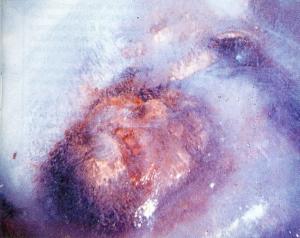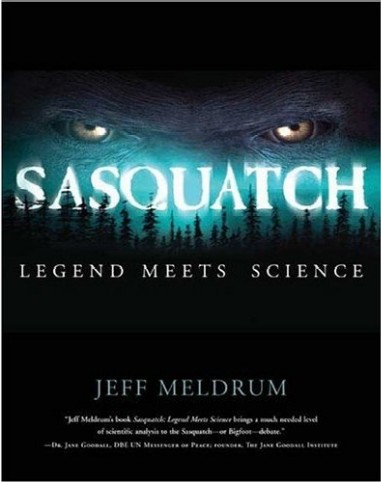
September 22, 2006

Is there a Russian-held Bigfoot carcass, which, unlike the Minnesota Iceman pictured above here, still physically exists for examination?
Could the search for the best sea otter furs have resulted in the source of the best evidence for Bigfoot ever known?
Sometimes, during Coast to Coast AM with George Noory, surprising stories are shared during the call-ins.
In the last hour of the overnight appearance of Jeff Meldrum’s and John Bindernagel’s discussion of Bigfoot, September 21-22, an American living in the Ukraine telephoned into the talk-radio program. The credible-sounding individual had an intriguing account.
The man identified himself as an environmental scientist. After the fall of the Soviet Union, he was hired to do air-quality studies at the museum in the university in the changing Leningrad. While taking air samples in a three-level basement beneath the museum in 1992, he said he made a startling find. [St. Petersburg was founded in 1703 by Tzar Peter the Great, but went through a period of having other names, Petrograd (1914–1924) and Leningrad (1924–1991).]
The American scientist related that he came across an object in a glass case that, according to the label, was an animal (an obvious Bigfoot) taken near a Russian outpost in northern California. The outpost was near Mendocino, and the mounted hominoid was collected in the late 1700s, from what he could tell on the museum label. The huge animal he saw, and said was examined, had several layers of skin, exhibited a foot 17 inches long, and was – amazingly – a 7 ft 1 in tall, hair-covered upright Bigfoot-like figure.
According to the dates of the founding of the universities in Saint Petersburg, this scientist could only be talking about the Saint Petersburg State University, which was founded in 1724. All the other universities in Saint Petersburg are technology, electrical, polytechnical and specialty institutes founded between 1828 and 1906. This could even be about the The State Hermitage Museum in Saint Petersburg.
A Russian discovery of an 18th or 19th century Californian Bigfoot body has never been mentioned before in any Russian, hominological or cryptozoological correspondence, book, or literature.
Could it be true? Could the ultimate evidence of the existence of Bigfoot be undisturbed in the basement of a Russian museum? Strange things have been found in museums, needless to say.
What evidence is there that the Russians were ever in California?
Of course, the short history of Russians intruding into the Spanish lands of California is well-documented.
A little bit of research shows that Russians seeking pelts of the sea otter (Enhydra lutris) near the Pacific coast, first established sites in Alaska and then moved down along the coast of California, looking for areas that might serve their purposes. In the “History of the Russian Settlement at Fort Ross, California,” the Russians appear to have mostly occupied the spots around San Francisco Bay from 1804 through 1829. The Russian who first came in 1804 was Ivan Alexandrovich Kuskov, and in 1812, he established (along with 25 Russians and almost 100 Aleuts) a fortified settlement on the California coast north of Bodega Bay.
Indeed, Fort Ross was a Russian fur trade outpost in what is now Sonoma County, California, United States, from the time of its establishment by the Russian-American Company in 1812, until it was sold to John Sutter (of Gold Rush fame) in 1841. (“Ross,” by the way, is a poetical shortened version of “Rossiya,” which is Russian for Russia.)
There are other names left on the landscape that give a clue to the Russians being in California. A well-known scenic site often visited today by hikers and tourists is the Russian River in California. The name did not drop out of the sky. The river takes its name from Russian trappers who explored the river in the early 19th century, when Russia maintained trade colonies and outposts, such as Fort Ross, along the Northern California coasts.
The Russian River rises in the coastal mountain ranges of Mendocino County, north of Ukiah in Northern California. Starting at Lake Mendecino, it flows south through valleys in Mendocino County and Sonoma County along Highway 101. The river turns west at Healdsburg and empties into the Pacific Ocean at Jenner-by-the-Sea, about 60 miles (100 km) north of the San Francisco Bay’s Golden Gate.
Considering that the Coast to Coast AM caller mentioned Mendocino from the museum label, all of these details appear to fit together (unless, of course, it was a hoax caller from a Russian River bed and breakfast or something weird like that). The caller said he thought the label said the late 1700s. Could the Bigfoot have been collected by one of the first surveying Russian exploration parties, looking for locations from which to take the sea otters?
This discovery, if uncovered, is too late for inclusion in Meldrum’s just published book, but if revealed in a Russian museum, won’t it be incredible that indirectly the publication of his new tome might cause this piece of evidence to be brought forward?

Sasquatch: Legend Meets Science by Jeff Meldrum.
Minnesota Iceman photograph above, Copyright Loren Coleman 1969.
About Loren Coleman
Loren Coleman is one of the world’s leading cryptozoologists, some say “the” leading living cryptozoologist. Certainly, he is acknowledged as the current living American researcher and writer who has most popularized cryptozoology in the late 20th and early 21st centuries.
Starting his fieldwork and investigations in 1960, after traveling and trekking extensively in pursuit of cryptozoological mysteries, Coleman began writing to share his experiences in 1969. An honorary member of Ivan T. Sanderson’s Society for the Investigation of the Unexplained in the 1970s, Coleman has been bestowed with similar honorary memberships of the North Idaho College Cryptozoology Club in 1983, and in subsequent years, that of the British Columbia Scientific Cryptozoology Club, CryptoSafari International, and other international organizations. He was also a Life Member and Benefactor of the International Society of Cryptozoology (now-defunct).
Loren Coleman’s daily blog, as a member of the Cryptomundo Team, served as an ongoing avenue of communication for the ever-growing body of cryptozoo news from 2005 through 2013. He returned as an infrequent contributor beginning Halloween week of 2015.
Coleman is the founder in 2003, and current director of the International Cryptozoology Museum in Portland, Maine.
Filed under Artifacts, Bigfoot, Breaking News, CryptoZoo News, Cryptozoologists, Cryptozoology, Museums, Sasquatch